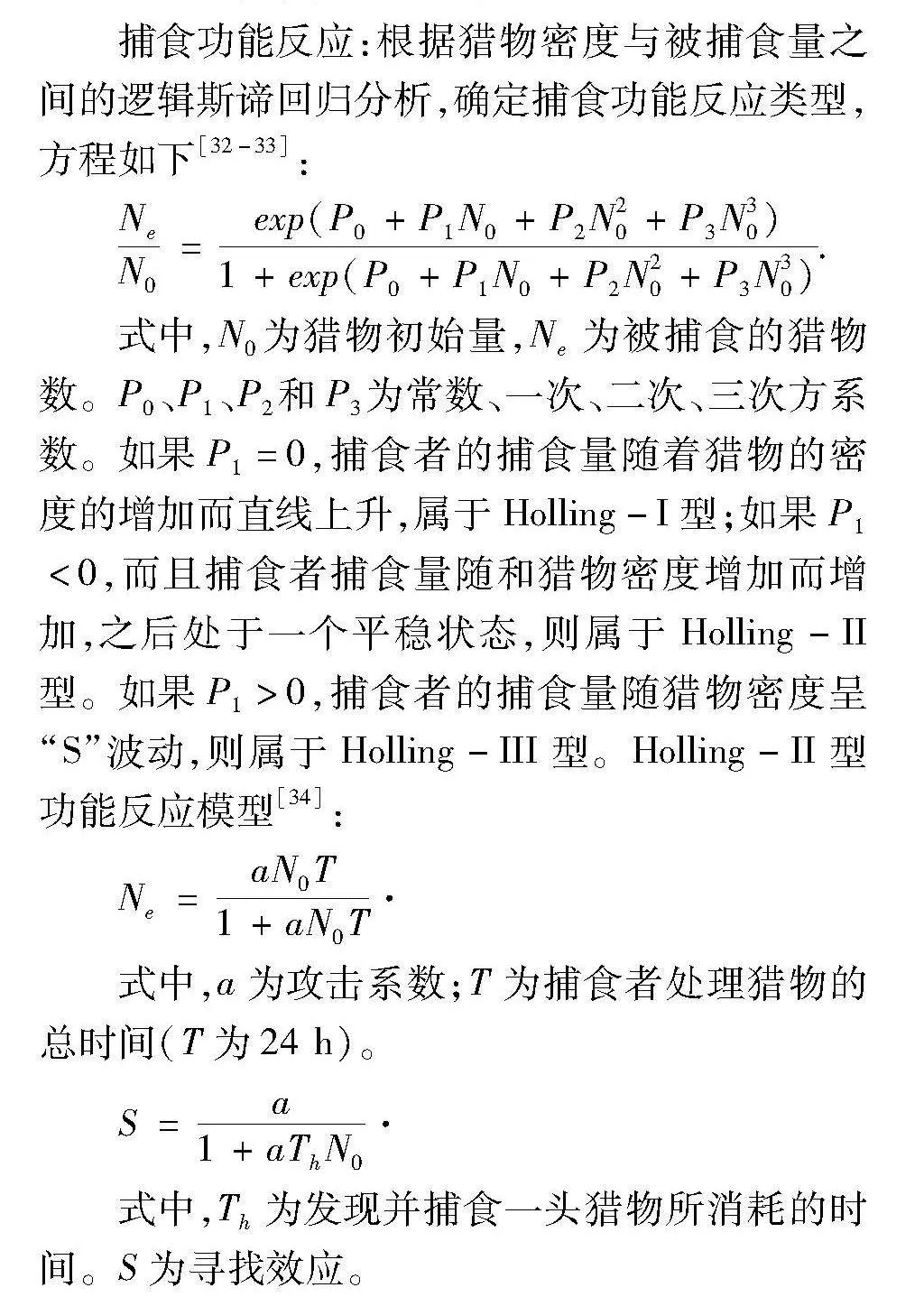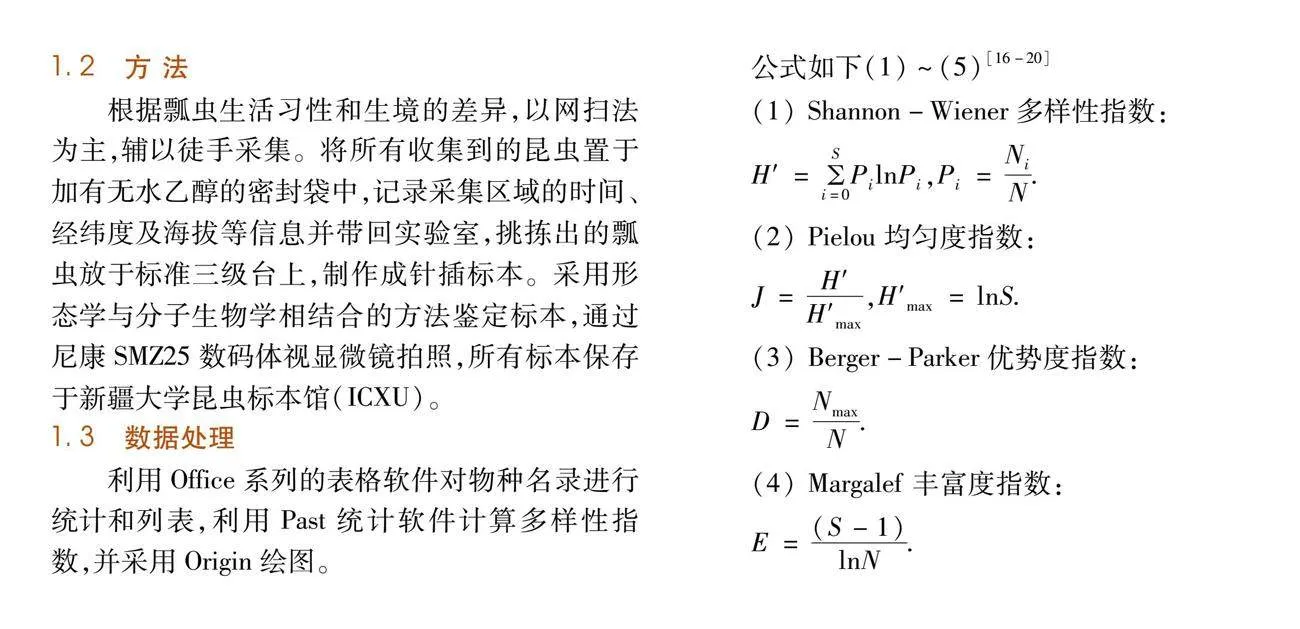
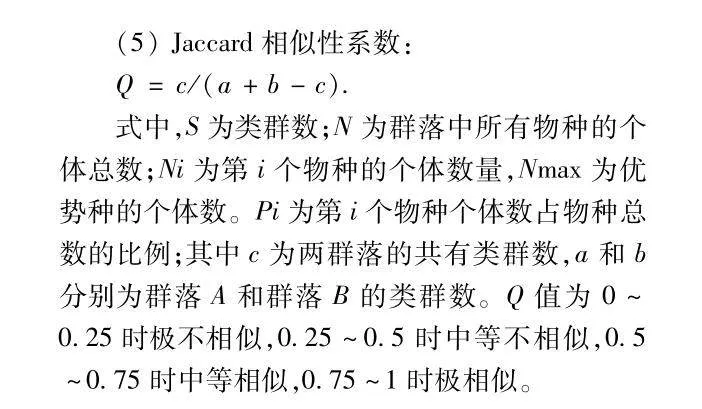
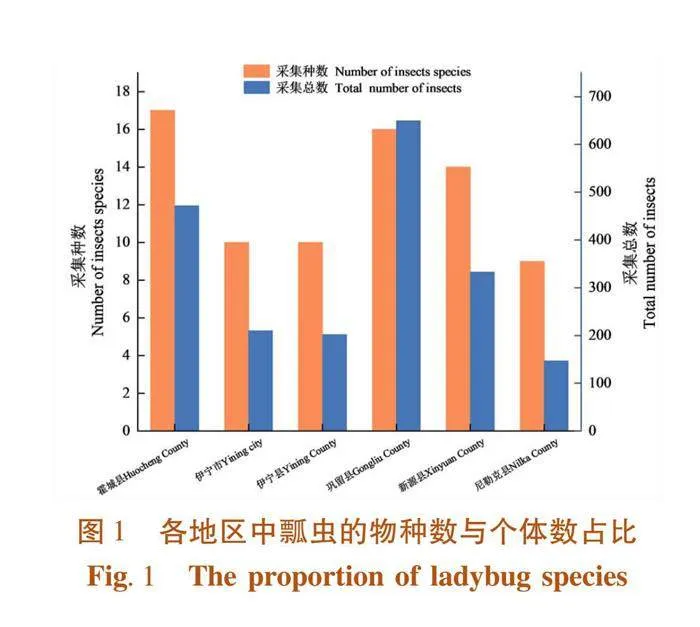
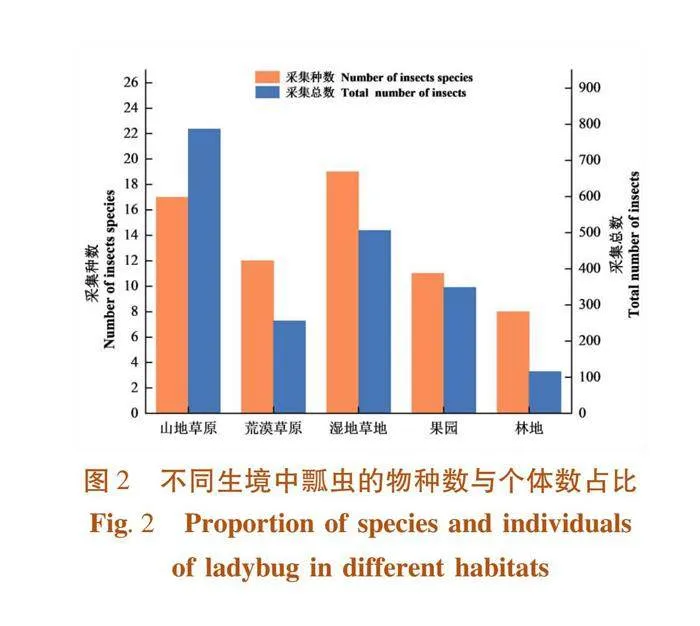
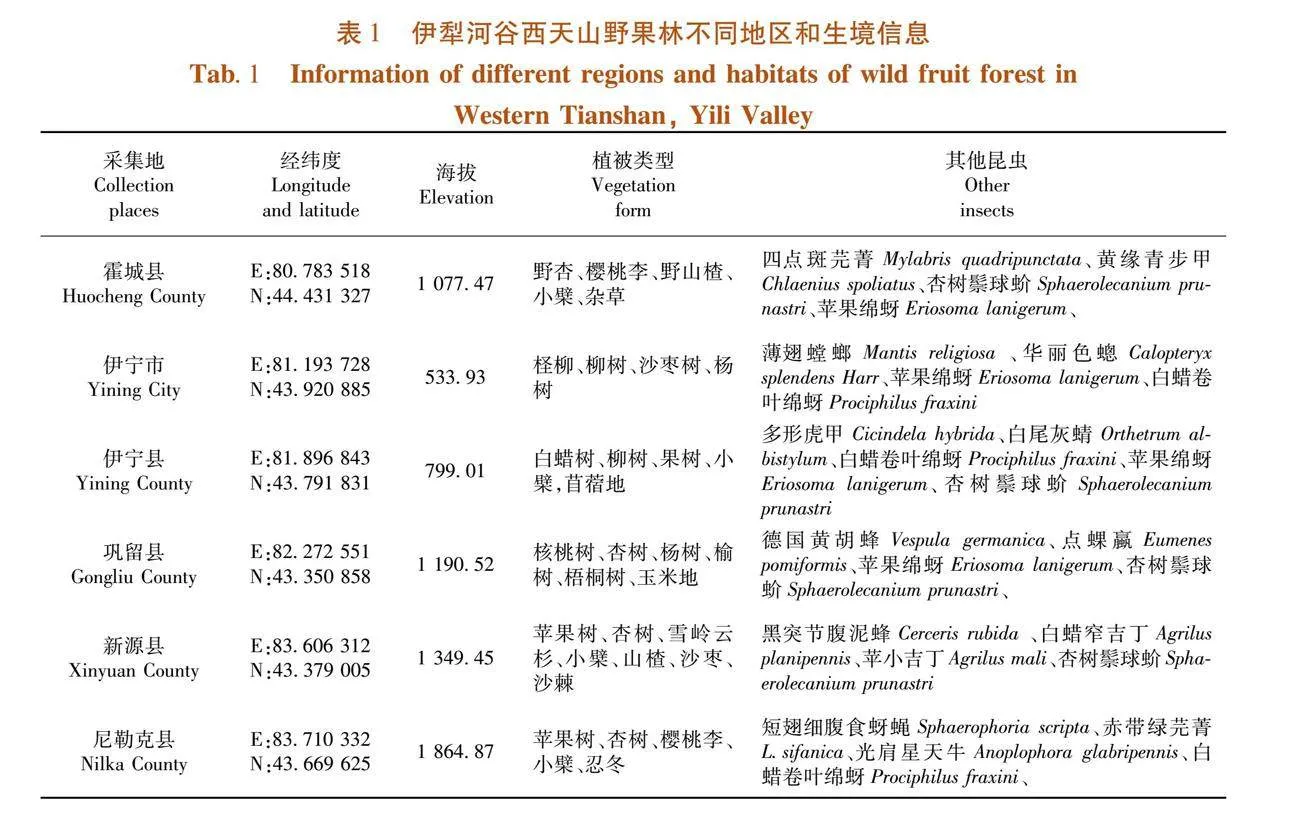
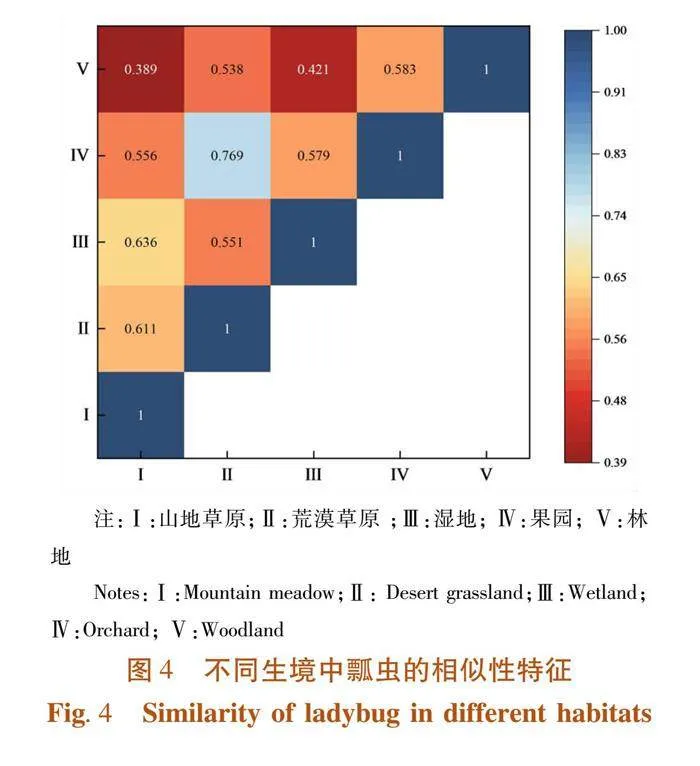
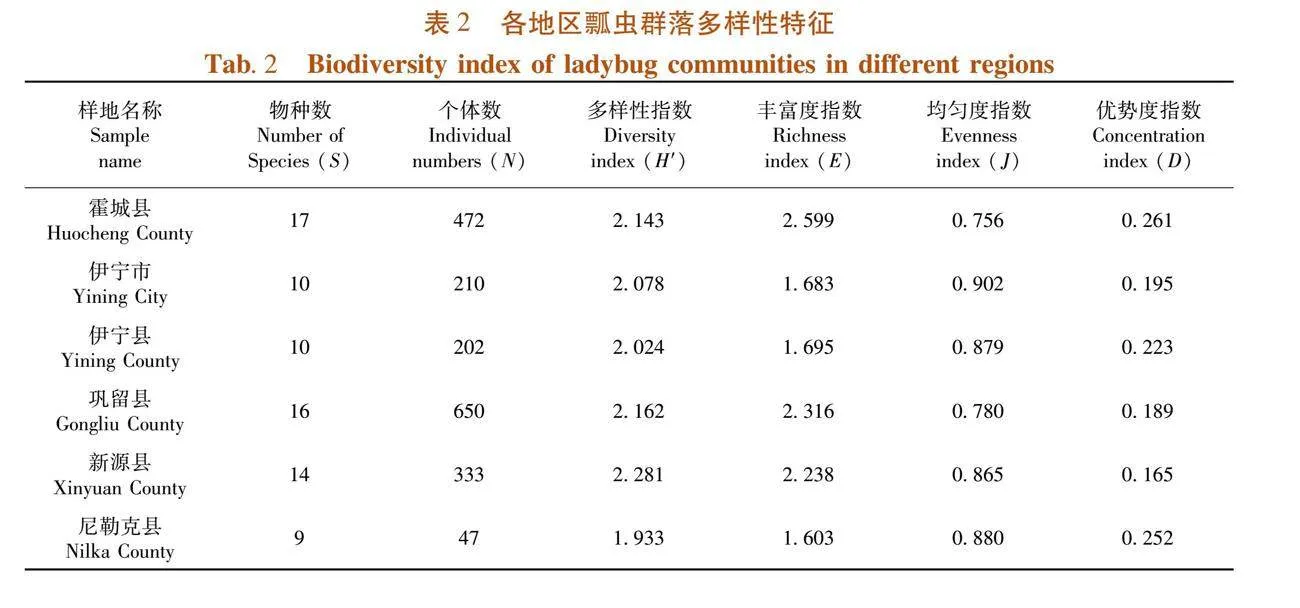
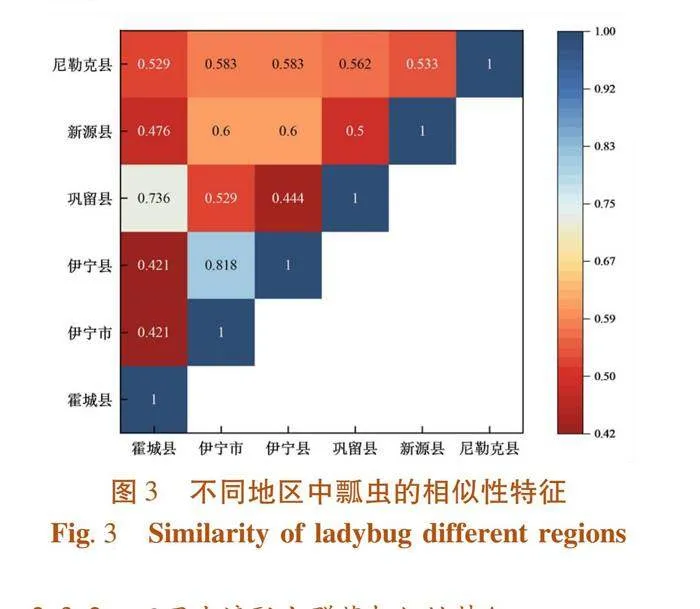
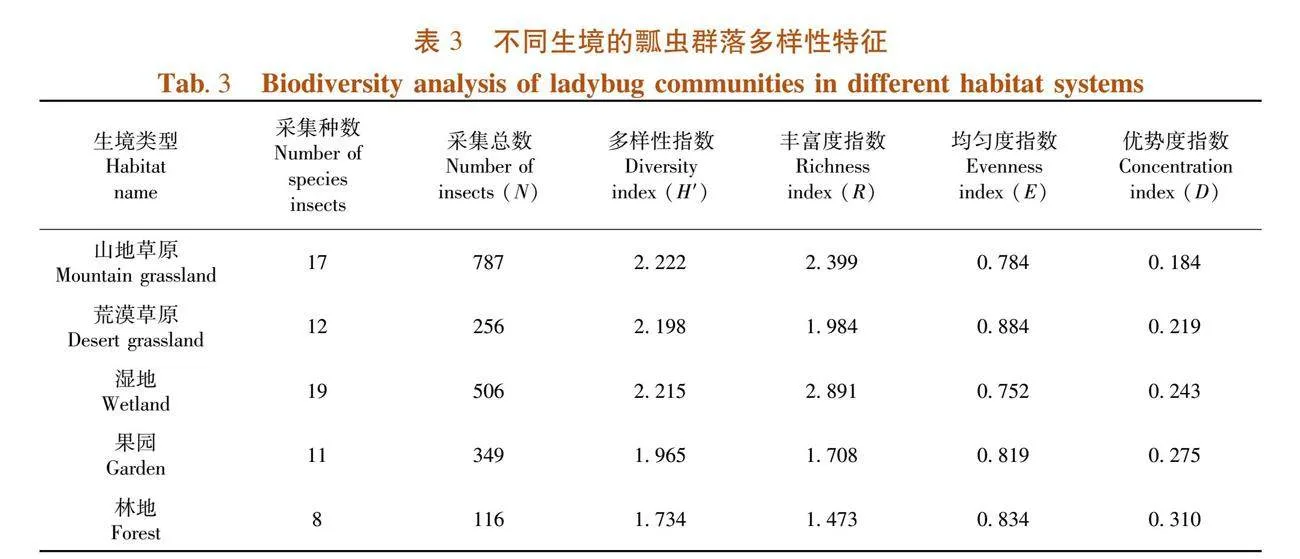
摘 要:【目的】调查分析新疆伊犁河谷西天山野果林不同生境中瓢虫群落多样性,为西天山野果林的生物多样性保护提供基础数据。
【方法】在2022~2023年的5~8月,系统调查伊犁河谷6个县市(霍城县、伊宁市、伊宁县、巩留县、新源县和尼勒克县)5种生境(包括山地草原、荒漠草原、湿地、果园、林地)共90个样点。
【结果】共采集2 014头瓢虫,隶属于13属23种。不同地区之间的瓢虫种群数量和物种组成差异显著:巩留县和霍城县瓢虫种群数量最多,而尼勒克县的瓢虫种群数量最少,多异瓢虫为优势种。不同生境间湿地的Margalef丰富度指数最高(2.891),而林地的最低(1.473)。多样性指数H′从高到低依次为山地草原gt;湿地gt;荒漠草原gt;果园gt;林地。均匀度指数E从高到低为荒漠草原gt;林地gt;果园 gt;山地草原gt;湿地。其次,不同生境之间的昆虫种群相似性存在差异,其中荒漠草原和果园的相似度系数最高为0.76(中等相似);而林地与山地草原以及湿地的相似度指数均低于0.5(不相似或者极不相似)。
【结论】湿地和山地草原等生境中的昆虫物种丰富度较高,是主要的昆虫物种储存库,其对应的昆虫群落多样性指数H′也较高,生境对瓢虫多样性具有重要影响。
关键词:捕食性;瓢虫;多样性指数;相似性;天敌昆虫保护
中图分类号:S436 ""文献标志码:A ""文章编号:1001-4330(2025)01-0210-07
收稿日期(Received):
2024-03-13
基金项目:
新疆第三次全国综合科学考察项目“天山野果林生态系统与生物多样性调查”之课题3“天山野果林昆虫多样性调查”(2021xjkk0503)
作者简介:
姚晓宇(1997-),女,新疆伊宁人,硕士研究生,研究方向为昆虫学,(E-mail)2498087810@qq.com
通信作者:
胡红英(1969-),女,新疆乌鲁木齐人,教授,博士,硕士生/博士生导师,研究方向为昆虫系统分类与害虫生物防治,(E-mail)huhongying@xju.edu.cn
0 引 言
【研究意义】生物多样性对于生态系统平衡具有重要意义[1-4]。伊犁河谷地处我国新疆北部,拥有丰富的自然资源和独特的生态环境[5]。西天山野果林是伊犁河谷主要生境之一,该区生物多样性对于维系伊犁河谷生态系统具有关键作用。瓢虫作为常见的捕食性天敌昆虫,主要捕食蚜虫、粉虱、介壳虫和叶螨等[6-9],其多样性对于维持生态平衡和促进农业的可持续发展至关重要[7,10]。但是,随着环境变化等因素,伊犁河谷西天山野果林的生态系统受到了影响[10-12],因此,有必要对伊犁河谷西天山野果林中捕食性瓢虫多样性进行研究。【前人研究进展】中国迄今记录的瓢虫包括10亚科,85属,680种[5]。姜双林[13]调查了陇东地区瓢虫资源多样性,结果表明瓢虫生物学特性与植物多样性有关。周文靖等[14]调查了黑龙江省双鸭山市果园捕食性天敌昆虫,果园受到农药的危害从而使得异色瓢虫、多异瓢虫等天敌数量大幅度降低。阿尔孜姑丽·肉孜等[15]调查了新疆农田系统瓢虫资源与多样性,共发现瓢虫26种,其中多异瓢虫为优势瓢虫。【本研究切入点】有关伊犁河谷天山野果林瓢虫多样性及空间分布特征的文献研究较少。需系统地收集伊犁河谷西天山野果林不同县市生境的捕食性瓢虫相关数据,包括种类、数量、分布和生境偏好等信息。【拟解决的关键问题】通过采用网扫和徒手采集相结合的野外调查方法,分析对该地不同地区和生境捕食性瓢虫群落多样性基础数据,为伊犁河谷生态保护和农林业可持续发展提供科学依据。
1 材料与方法
1.1 材 料
针对伊犁河谷西天山野果林霍城县、伊宁市、伊宁县、巩留县、新源县和尼勒克县等6个县市的不同生境捕食性瓢虫进行全面调查。于2022年5月至2023年8月,在该地区6个样地中选取5个不同生境类型,包括山地草原、荒漠草原、湿地、果园和林地。每个生境设置3条不同方向的样线,每条样线长500 m。表1
1.2 方 法
根据瓢虫生活习性和生境的差异,以网扫法为主,辅以徒手采集。将所有收集到的昆虫置于加有无水乙醇的密封袋中,记录采集区域的时间、经纬度及海拔等信息并带回实验室,挑拣出的瓢虫放于标准三级台上,制作成针插标本。采用形态学与分子生物学相结合的方法鉴定标本,通过尼康SMZ25数码体视显微镜拍照,所有标本保存于新疆大学昆虫标本馆(ICXU)。
1.3 数据处理
利用Office系列的表格软件对物种名录进行统计和列表,利用Past统计软件计算多样性指数,并采用Origin绘图。公式如下(1)~(5)[16-20]
(1) Shannon-Wiener多样性指数:
H′=Si=0PilnPi,Pi=NiN.
(2) Pielou均匀度指数:
J=H′H′max,H′max=lnS.
(3) Berger-Parker优势度指数:
D=NmaxN.
(4) Margalef 丰富度指数:
E=(S-1)lnN.
(5) Jaccard相似性系数:
Q=c/(a+b-c).
式中,S为类群数;N为群落中所有物种的个体总数;Ni为第i个物种的个体数量,Nmax为优势种的个体数。Pi为第i个物种个体数占物种总数的比例;其中c为两群落的共有类群数,a和b分别为群落A和群落B的类群数。Q值为 0~0.25时极不相似,0.25~0.5时中等不相似,0.5~0.75时中等相似,0.75~1时极相似。
2 结果与分析
2.1 伊犁河谷西天山野果林各地区瓢虫组成和群落多样性
研究表明,伊犁河谷西天山野果林不同地区各种生境的瓢虫标本共2 014头,隶属于13属23种。标本数量,由多至少依次为巩留县gt;霍城县gt;新源县gt;伊宁市gt;伊宁县gt;尼勒克县,巩留县的瓢虫个体数量最多为650头,其次为霍城县472头,而尼勒克县的物种数和个体数量最少,只有147头;从物种数来看,霍城县的瓢虫物种最丰富为17种,其次是巩留县为16种,尼勒克县物种数最少为9种。
新源县和巩留县的多样性指数均很高(2.281、2.162),而丰富度指数最高的为霍城县(2.599),其次为新源县(2.316),尼勒克县的多样性指数和丰富度指数最低(1.933、1.603)。虽然伊宁市的多样性指数和丰富度指数均不高,但其均匀度指数最高(0.902 4)。Berger-Parker优势度指数D由高到低依次为霍城县(0.261)gt;尼勒克县(0.252)gt;伊宁县(0.223)gt;伊宁市(0.195)gt;巩留县(0.189)gt;新源县(0.165)。表2,图1
2.2 伊犁河谷西天山野果林各生境瓢虫组成和群落多样性
研究表明,不同生境类型,瓢虫数量由高到低依次为山地草原gt;湿地gt;果园gt;荒漠草原gt;林地,Shannon-Wiener多样性指数H′由高到低为山地草原gt;湿地gt;荒漠草原gt;果园gt;林地;其中,山地草原的Shannon-Wiener多样性指数H′最高(2.222),显著高于湿地(2.215)、荒漠草原(2.198)、果园(1.965)、林地(1.734)。Margalef丰富度指数 R 由高到低依次为湿地gt;山地草原gt;荒漠草原gt;果园gt;林地,湿地的Margalef丰富度指数最高为2.891,显著高于山地草原(2.399),其中林地的Margalef丰富度指数R最低为1.473。Pielou均匀度指数E由高到低依次为荒漠草原>林地>果园>山地草原>湿地;荒漠草原的Pielou均匀度指数E最高为0.884,显著高于林地(0.834)、果园(0.819)、山地草原(0.784)、湿地(0.752)。表3,图2
2.3 伊犁河谷西天山野果林瓢虫群落相似性
2.3.1 不同地区瓢虫群落相似性特征
研究表明,依据Jaccard相似性系数原理,当相似性系数处于0~0.25时,2种生境为极不相似;当处于0.25~0.5时为中等不相似;当处于为0.5~0.75时,为中等相似;0.75~1为极相似。伊犁河谷西天山野果林6县市中,伊宁市和伊宁县的昆虫群落相似度系数最高为0.818,表现为极相似;其新源县与伊宁市和伊宁县的相似度相同为0.600,表现为中等相似,而霍城县与伊宁市和伊宁县的相似度相同为0.421,表现为中等不相似。图3
2.3.2 不同生境瓢虫群落相似性特征
研究表明,伊犁河谷西天山野果林5种生境中,果园和荒漠草原的昆虫群落相似度系数最高为0.769,表现为极相似;其次为湿地和山地草原与山地草原和荒漠草原为0.636、0.611,表现为中等相似,而林地和山地草原与湿地的昆虫群落相似度指数最低为0.389和0.421,表现为中等不相似。图4
3 讨 论
3.1
伊犁河谷西天山野果林分布的瓢虫隶属于13属23种。其中多异瓢虫有 375头标本,占据主体。该结果与阿尔孜姑丽·肉孜等[15]关于新疆各地州农田系统中多异瓢虫占绝对优势的研究结果相似。而多异瓢虫作为农林系统中重要的捕食性天敌,对蚜虫具有明显的控制作用[7]。
瓢虫的群落多样性在伊犁河谷西天山野果林地区空间分布具有显著差异。其中,湿地和山地草原的多样性最丰富,表现出更高的Margalef丰富度指数和多样性指数(H′)。这些生境比其他生境拥有更丰富的植被和资源,提供了适合多种瓢虫物种生存的条件[21,22]。相比之下,果园和林地中的瓢虫物种数与多样性相对较低[4,23]。瓢虫在不同生境中的均匀度表现出差异,反映了物种对生境选择的差异性[24]。相反,山地草原和湿地中的瓢虫显示出更高的均匀度,可能与更丰富的资源和较低的竞争有关。
3.2
生境相似性分析揭示了不同生境之间的关系。果园与山地草原之间的相似性低,可能与果园植被结构单一的相似性有关[25],加上果园中农药的频繁使用导致捕食性天敌瓢虫群落的多样性减少。而且林地与山地草原和湿地之间的相似性较低[26-28]。研究结果强调了生境对物种多样性重要影响。不同生境为不同种瓢虫提供了相适宜的生存条件,有助于维持昆虫群落的多样性和生态平衡[29-31]。因此有必要对湿地和山地草原进行保护,以确保生态系统健康和生物物种多样,提高生态系统服务和农业可持续性发展能力[12]。
今后可以进一步深入探讨瓢虫与其它生态要素之间的相互作用,以更全面地了解关键昆虫群体在生态系统中的作用。
4 结 论
4.1
伊犁河谷西天山野果林地区的捕食性瓢虫多样性相当丰富,共鉴定出13属23种瓢虫。不同地区之间存在显著的捕食性瓢虫数量和物种组成差异。多异瓢虫为优势种,其中巩留县和霍城县是捕食性瓢虫数量最多的地区,而尼勒克县的捕食性瓢虫数量最少。霍城县的物种多样性最高,而尼勒克县的物种多样性最低。
4.2
多样性指数(如多样性和丰富度指数)的结果显示,霍城县和新源县的生态系统具有较高的多样性水平,而巩留县也表现出相对较高的多样性,表明这些地区的生态系统更加丰富和多元化。伊宁市虽然在多样性方面不如其他地区高,但在均匀度方面依然较高。
参考文献(References)
[1]谢寿安, 张雅林, 袁锋, 等. 我国昆虫多样性的保护和利用[J]. 西北林学院学报, 2001, 16(2): 50-53.
XIE Shouan, ZHANG Yalin, YUAN Feng, et al. Conservation and utilization of the insect diversity in China[J]. Journal of Northwest Forestry College, 2001, 16(2): 50-53.
[2] 吴燕如. 我国昆虫多样性研究及保护概况[J]. 生物科学信息, 1990, 2(4): 166-168.
WU Yanru. Survey of insect diversity research and conservation in China[J]. Chinese Bulletin of Life Sciences, 1990, 2(4): 166-168.
[3] Landmann T, Schmitt M, Ekim B, et al. Insect diversity is a good indicator of biodiversity status in Africa[J]. Communications Earth amp; Environment, 2023, 4: 234.
[4] Shipley J R, Gossner M M, Rigling A, et al. Conserving forest insect biodiversity requires the protection of key habitat features[J]. Trends in Ecology amp; Evolution, 2023, 38(9): 788-791.
[5]林培钧, 廖明康. 我国珍存的伊犁野果林亟待保护[J]. 新疆林业, 1986, (5): 30–31.
LIN Peijun, LIAO Mingkang. China s precious Yili wild fruit forest needs to be protected[J]. Xinjiang Forestry, 1986, (5) : 30-31
[6] 高爱保. 中国瓢虫的物种多样性[J]. 江西植保, 2006, 29(1): 32-33, 31.
GAO Aibao. Species diversity of ladybirds (Coccinellidae: Coleoptera) in China[J]. Jiangxi Plant Protection, 2006, 29(1): 32-33, 31.
[7] 任丽娜, 崔洁, 王向向, 等. 我国捕食性瓢虫生物防治研究现状[J]. 西藏农业科技, 2022, 44(3): 96-99.
REN Lina, CUI Jie, WANG Xiangxiang, et al. Status of research on biological control of predatory ladybugs in China[J]. Tibet Journal of Agricultural Sciences, 2022, 44(3): 96-99.
[8] Sloggett J J. Aphidophagous ladybirds (Coleoptera: Coccinellidae) and climate change: a review[J]. Insect Conservation and Diversity, 2021, 14(6): 709-722.
[9] Magro A, Lecompte E, Magné F, et al. Phylogeny of ladybirds (Coleoptera: Coccinellidae): Are the subfamilies monophyletic?[J]. Molecular Phylogenetics and Evolution, 2010, 54(3): 833-848.
[10] Iperti G. Biodiversity of predaceous Coccinellidae in relation to bioindication and economic importance[J]. Agriculture, Ecosystems amp; Environment, 1999, 74(1/2/3): 323-342.
[11] Dillen M, Smit C, Buyse M, et al. Stronger diversity effects with increased environmental stress: a study of multitrophic interactions between oak, powdery mildew and ladybirds[J]. PLoS One, 2017, 12(4): e0176104.
[12] Sethuraman A, Janzen F J, Rubio M A, et al. Demographic histories of three predatory lady beetles reveal complex patterns of diversity and population size change in the United States[J]. Insect Science, 2018, 25(6): 1065-1079.
[13] 姜双林. 陇东地区瓢虫群落多样性的研究[J]. 西北农业学报, 2006, 15(2): 63-65.
JIANG Shuanglin. Studies on the diversity of ladybug communities in the eastern area of Gansu Province[J]. Acta Agriculturae Boreali-Occidentalis Sinica, 2006, 15(2): 63-65.
[14] 周文靖, 王建楠, 张斯琦, 等. 双鸭山地区果园害虫的捕食性天敌昆虫种类调查[J]. 安徽农业科学, 2018, 46(17): 146-147, 152.
ZHOU Wenjing, WANG Jiannan, ZHANG Siqi, et al. Investigation on predatory insect pests of orchard pests in Shuangyashan area[J]. Journal of Anhui Agricultural Sciences, 2018, 46(17): 146-147, 152.
[15] 阿尔孜姑丽·肉孜, 丁新华, 吐尔逊·阿合买提, 等. 新疆农田系统瓢虫资源调查与多样性研究[J]. 环境昆虫学报, 2021, 43(2): 292-304.
Aerziguli Rouzi, DING Xinhua, Tuerxun Ahemaiti, et al. Investigation and diversity of ladybug resources of farmland system in Xinjiang[J]. Journal of Environmental Entomology, 2021, 43(2): 292-304.
[16] 陈廷贵, 张金屯. 十五个物种多样性指数的比较研究[J]. 河南科学, 1999, 17(S1): 62-64, 78.
CHEN Tinggui, ZHANG Jintun. Comparative study on diversity index of fifteen species[J]. Henan Science, 1999, 17(S1): 62-64, 78.
[17] 马克平, 黄建辉, 于顺利, 等. 北京东灵山地区植物群落多样性的研究Ⅱ丰富度、均匀度和物种多样性指数[J]. 生态学报, 1995, 15(3): 268-277.
MA Keping, HUANG Jianhui, YU Shunli, et al. Plant community diversity in Dongling mountain, Beijing, China: Ⅱ. species richness, evenness and species diversities[J]. Acta Ecologica Sinica, 1995, 15(3): 268-277.
[18] 马克平, 钱迎倩. 生物多样性保护及其研究进展[J]. 应用与环境生物学报, 1998, 4(1): 96-100.
MA Keping, QIAN Yingqian. Biodiversity Conservation and Its Research Progress[J]. Chinese Journal of Applied and Environmental Biology, 1998, 4(1): 96-100.
[19] 马克平, 刘玉明. 生物群落多样性的测度方法 Ⅰα多样性的测度方法(下)[J]. 生物多样性, 1994, 2(4): 229-239.
MA Keping, LIU Yuming. Method for measuring biodiversity of biological community iαMethod for measuring biodiversity (down)[J]. Biodiversity Science, 1994, 2(4): 229-239.
[20] 马克平, 刘灿然, 刘玉明. 生物群落多样性的测度方法Ⅱβ多样性的测度方法[J]. 生物多样性, 1995, 3(1): 229-239.
MA Keping, LIU Canran, LIU Yuming. Measurement Method of Biocommunity DiversityIIMeasurement Method of β Diversity[J]. Biodiversity Science, 1995, 3(1): 229-239.
[21] Magagula C N, Samways M J. Maintenance of ladybeetle diversity across a heterogeneous African agricultural/savanna land mosaic[J]. Biodiversity amp; Conservation, 2001, 10(2): 209-222.
[22] Banks J E, Yasenak C L. Effects of plot vegetation diversity and spatial scale on Coccinella septempunctata movement in the absence of prey[J]. Entomologia Experimentalis et Applicata, 2003, 108(3): 197-204.
[23] 阿尔孜姑丽·肉孜, 丁新华, 吐尔逊·阿合买提, 等. 新疆伊犁河谷地区瓢虫种类及其群落组成与结构分析[J]. 新疆农业科学, 2020, 57(3): 507-518.
Aerziguli Rouzi, DING Xinhua, Tuerxun Ahemaiti, et al. A preliminary report on the species of natural enemies ladybug in Yili valley of Xinjiang[J]. Xinjiang Agricultural Sciences, 2020, 57(3): 507-518.
[24] 阿尔孜姑丽·肉孜, 吐尔逊·阿合买提, 付开赟, 等. 新疆玉米种植区瓢虫资源调查及多样性分析[J]. 中国生物防治学报, 2020, 36(5): 697-707.
Aerziguli Rouzi, Tuerxun Ahemaiti, FU Kaiyun, et al. Investigation and diversity analysis of lady beetle resources in corn producing areas of Xinjiang[J]. Chinese Journal of Biological Control, 2020, 36(5): 697-707.
[25] Song X X, Ji L, Liu G M, et al. Patterns and drivers of aboveground insect diversity along ecological transect in temperate grazed steppes of eastern Eurasian[J]. Insects, 2023, 14(2): 191.
[26] Wang J H, Ren B B, Shao J L, et al. Impact of plant community structure and its diversity on richness and abundance of arthropod aphidophagous natural enemy community[J]. Urban Forestry amp; Urban Greening, 2023, 81: 127850.
[27] Pelliza Y I, Souto C P, Tadey M. Unravelling effects of grazing intensity on genetic diversity and fitness of desert vegetation[J]. Perspectives in Ecology and Conservation, 2020, 18(3): 178-189.
[28] Curran M F, Robinson T J, Guernsey P, et al. Insect abundance and diversity respond favorably to vegetation communities on interim reclamation sites in a semi-arid natural gas field[J]. Land, 2022, 11(4): 527.
[29] Honek A, Dixon A F, Soares A O, et al. Spatial and temporal changes in the abundance and compostion of ladybird (Coleoptera: Coccinellidae) communities[J]. Current Opinion in Insect Science, 2017, 20: 61-67.
[30] Minor A K, Eichholz M W, Liechty J S. Vegetation richness, diversity, and structure influence arthropod communities of native and restored northern mixed-prairies[J]. Restoration Ecology, 2021, 29(7): e13407.
[31] Tu T H, Wang J R, Gu J Q, et al. Effects of habitat fragmentation on the functional diversity of insects in Thousand Island Lake, China[J]. Entomological Research, 2019, 49(2): 93-104.
Diversity and spatial distribution of ladybird in Western Tianshan
wild fruit forest in Ili River Valley
YAO Xiaoyu,HU Hongying, KANG Ning,XIONG Shihao
(College of Life Science and Technology of Xinjiang University, Xinjiang Key Laboratory of Biological Resources and Genetic Engineering, Urumqi 830017, China)
Abstract:【Objective】 This study conducted a survey on ladybug community diversity in different habitats of the western Tianshan Mountains wild fruit forests in the Ili River Valley,Xinjiang.The aim was to provide fundamental data for biodiversity conservation in the western Tianshan Mountains wild fruit forests.
【Methods】" From May to August 2022-2023, a systematic survey was conducted in six counties and cities in the Ili River Valley (Huocheng County, Yining City, Yining County, Gongliu County, Xinyuan County, and Nilka County) across five habitats (mountain grassland, desert grassland, wetland, orchard, and woodland), totaling 90 sampling points.
【Results】" A combined method of sweep netting and hand collection was employed, yielding a total of 2,014 ladybugs belonging to 13 genera and 23 species.Results indicated significant variations in ladybug population and species composition among different regions, Hippodamia variegata is the dominant species,with Gongliu County and Huocheng County having the highest ladybug populations, while Nilka County had the lowest.Ladybug Margalef richness index ranked from high to low as wetland gt; mountain grassland gt; desert grassland gt; orchard gt; woodland, with wetland having the highest index (2.891) and woodland the lowest (1.473).Diversity index H′ ranked from high to low as mountain grassland gt; wetland gt; desert grassland gt; orchard gt; woodland.Evenness index E ranked from high to low as desert grassland gt; woodland gt; orchard gt; mountain grassland gt; wetland.Additionally, there were differences in insect community similarity among different habitats.The similarity coefficient between desert grassland and orchard was the highest at 0.76, indicating moderate similarity.However, woodlands similarity with mountain grassland and wetland was below 0.5, indicating dissimilarity or extreme dissimilarity.
【Conclusion】" Insect species richness was higher in habitats like wetland and mountain grassland, serving as significant reservoirs for insect species.The corresponding insect community diversity index H was also higher, highlighting the habitats crucial impact on ladybug diversity.
Key words:predatory; ladybug; diversity index; similarity; natural enemy insect protection
Fund projects:Topic 3 of the Third Comprehensive Scientific Investigation Project \"Investigation of Ecosystem and Biodiversity in Tianshan Wild Fruit Forest\" in Xinjiang \"Investigation of Insect Diversity in Tianshan Wild Fruit Forest\" (2021xjkk0503)
Correspondence author: HU Hongying(1969-), female, from Urumqi,Xinjiang,professor, Ph.D., master/doctorals supervisor,research direction: systematic classification of insects and biological control of pests,(E-mail)huhongying@xju.edu.cn

